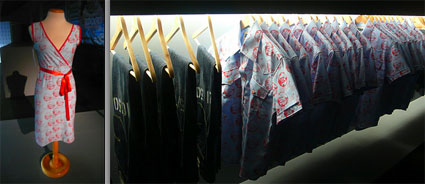
A few months ago, i bought a lovely baby blue summer dress with the face of Karl Marx printed all over it. I was made slightly uncomfortable by the irony of acting like a victim of capitalism in the face of and to the detriment of the father of anti-capitalism. I also had the feeling that, somewhere, a bunch of cynical and astute artists were making fun of me. Because that’s exactly what happened. The provocative brand has a slogan ‘Be Like Us, Be Different’, and a shop, located at the time in an art exhibition room, right inside LABoral Centro de Arte y Creación Industrial in Gijon. Gallery visitors could buy jeans carrying the MARX® logo, boys short-sleeve shirts with the same pattern as the said blue dress and some very expensive MARX® shoes. The shop has now moved to another museum, the CAAM in Las Palmas de Gran Canaria, Spain.
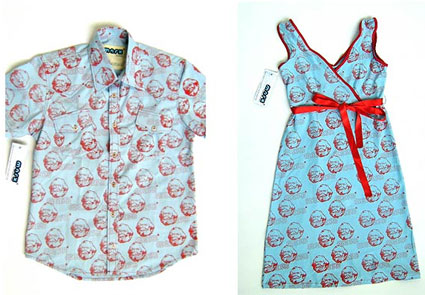
The artists/company who designed and market the dress are Berlin-based art collective PSJM, made up of Pablo San José and Cynthia Viera. PSJM acts as an trademark of happening art addressing issues of the artwork in the market, communication with consumers, or function as an artistic quality, using communication resources borrowed from capitalism of the spectacle to underscore the paradoxes produced by its unbridled development.
Having googled the name of the artists i found a series of interviews, statement texts and essays so interesting that i immediately thought that it would be foolish of me to stop my enthusiasm at the cuteness of a blue dress. Hence this interview (the original version of PSJM’s answers is in spanish, i pasted it at the bottom of this post):
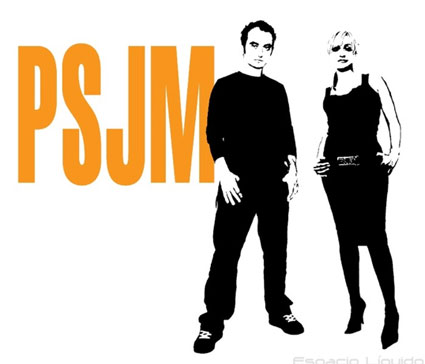 PSJM is made of artist Pablo San José and management graduate Cynthia Viera. Excuse the banality of my prejudice but how can people with such a different background manage to dialog? What brought you together? Did Cynthia’s mindset and knowledge influence Pablo’s artistic practice and view of the contemporary art landscape? And vice-versa, have Cynthia’s management skills been “affected” by her collaboration with an artist?
PSJM is made of artist Pablo San José and management graduate Cynthia Viera. Excuse the banality of my prejudice but how can people with such a different background manage to dialog? What brought you together? Did Cynthia’s mindset and knowledge influence Pablo’s artistic practice and view of the contemporary art landscape? And vice-versa, have Cynthia’s management skills been “affected” by her collaboration with an artist?
In reality we do not have such different backgrounds. At some point during his artistic career, Pablo worked for some years as a creative for a big corporation of the advertisement sector, creating campaigns and brand images for international companies. In 1998, and in parallel to his work in publicity, Pablo decided that his artistic signature would become a brand. He was interested by the promotion processes of artistic brands and its parallelism with other commercial brands. He then started a work that continues today, a project that builds itself with each work realized. “The artist is the brand, the work is the product” became the slogan of the PSJM brand. In 2003, Cynthia, a graduate in Direction of International Commerce and Marketing, and until then working as the Head of Marketing Services for a major telecommunication company, joined the project. With her arrival, the theoretical objectives to work under the same structures as a company and to legally establish the team as a commercial brand became reality. We work as a team in which the point of view of each of us affects without a doubt the work of the other one. However, we both use the same language. Pablo doesn’t correspond to the typical romantic idea of the artist more than Cynthia fits the usual profile of an executive who puts the quest for maximum benefits above social or aesthetic commitments.
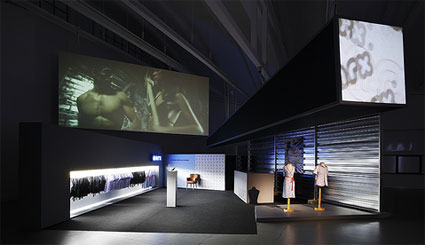 Photo: © LABoral – Author Marcos Morilla
Photo: © LABoral – Author Marcos Morilla
One of the striking elements of the MARX® brand is the price. All the garments, be they jeans or dress, carry the same price tag (220,40 euros), while the one and only shoe available costs way more than most people could afford. What were the motivations behind the price tags?
While the main objective of marketing is to satisfy the client in exchange of economic benefits, we use marketing as a critical tool that enables us to provide consumers with an aesthetic or intellectual gratification. We use the “4 Ps” of the Marketing Mix (Product, Price, Promotion and Placement) to interweave a strategy of meaning where each of these
“Ps” is regarded as a creative opportunity, as a poetic license. This way, the product constitute the artwork, the price constitutes the artwork the promotion is in itself an artwork and the distribution (placement) is also part and parcel of the artwork. We like to call ‘Marketing experimental’ this process of experimentation of a representational kind.
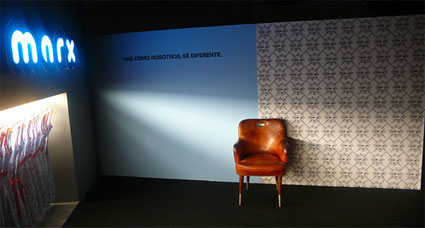
With MARX® we have used once again the price as a poetic license and vehicle of meaning. The fact that garments exhibited have a high price tag creates some kind of reflective impotence in the mind of the visitor who has finally the opportunity to act as a consumer in the museum space but is inhibited by the aspect of the aspect of exclusivity of the goods. In any case and in order to keep the work alive and continue creating meanings and mixing reality and fiction, and because the next exhibition of the garments will be at the CAAM in July, they will be on sale. Let’s see what happens.
I don’t know if you’ve read about the fight that the daughter of Che Guevara is putting to protect her father’s image.
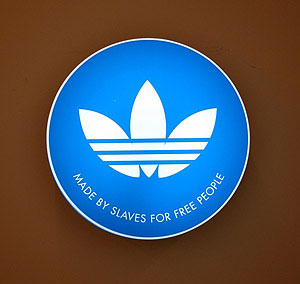 How did you deal with the thought that some people might come up and criticize you for using Marx’ figure in a way that they consider to “be an affront to his dignity”? And did you at any moment think that you’d encounter a censorship similar to the one you experienced with one of your previous works, Project Asia?
How did you deal with the thought that some people might come up and criticize you for using Marx’ figure in a way that they consider to “be an affront to his dignity”? And did you at any moment think that you’d encounter a censorship similar to the one you experienced with one of your previous works, Project Asia?
The experimental aspect of our projects involves a certain dose of uncertainty once we are launching the work. Even if you try to direct the work towards a certain meaning you never know the kind of reaction you’re going to encounter. All along our career we had to face anything from censorships from brands, complains from right-wing to passionate critiques, either negative or favorable.
For example, with the public intervention that took the shape of a promotional campaign for the MARX® brand in Gijón, we were expecting some forms of violent reaction to the association of the name of the father of communism with the aesthetic of fashion, especially if we take into account the revolutionary tradition of Asturias. But to our surprise the public is so used to the absurdity of the paradoxical messages emerging from the market that the work got totally diluted into the reality.
On the other hand, in this case, it would be difficult for any brand to censor us, as Adidas did with the Asia Project. The first conceptual and practical step of the MARX® project consisted in registering the brand MARX®, and it is this action which really supports the main axis of the artwork, the rest can only be seen as its natural development.
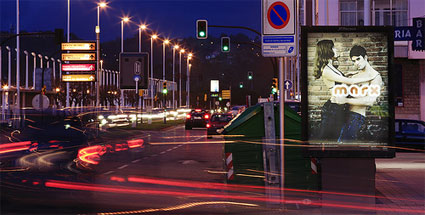 Photo: © LABoral – Author Marcos Morilla
Photo: © LABoral – Author Marcos Morilla
The MARX® project was accompanied with a promotional campaign in the streets of Gijon. The promo posters looked like any other posters designed by mainstream fashion brand. The general public, whether they wanted it or not, was thus in direct contact with your project. How much do you value their look and reaction to your work? Do you give it more credit and importance than you would give to an art critic or to anyone familiar with artistic discourses?
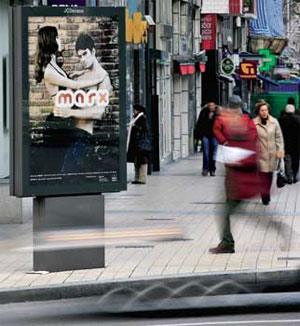 For us it is crucial that our proposals should not remain exclusively at the reach of the cultural elite. The commitment to open up our discourse to a broader public is at the basis of our work, we strive to create pieces which have two levels of lectures and try to unite experimentation and communication. We call this difficult operation ” the dilemma of Mayakovsky“, as it was a theme that kept the Russian poet awake at night. To achieve this we use the media and the strategies of mass culture. The broad public understands perfectly its language and this provides us with a space for experimenting while generating various meanings. However, we also have the objective of placing our proposals inside the theoretical discourse of contemporary art, all our projects involve a text which we write ourselves and which constitutes and additional element of the art piece. Our work can be situated between reality and the art institution, both spheres are important to us.
For us it is crucial that our proposals should not remain exclusively at the reach of the cultural elite. The commitment to open up our discourse to a broader public is at the basis of our work, we strive to create pieces which have two levels of lectures and try to unite experimentation and communication. We call this difficult operation ” the dilemma of Mayakovsky“, as it was a theme that kept the Russian poet awake at night. To achieve this we use the media and the strategies of mass culture. The broad public understands perfectly its language and this provides us with a space for experimenting while generating various meanings. However, we also have the objective of placing our proposals inside the theoretical discourse of contemporary art, all our projects involve a text which we write ourselves and which constitutes and additional element of the art piece. Our work can be situated between reality and the art institution, both spheres are important to us.
You obviously don’t share Takashi Murakami‘s bulldozer and very mercantile approach. However, MARX® and other projects of yours evoke (to me at least and under certain aspects) the Japanese artist’s exploration of the merging between consumer goods and artwork, art fetishism, the demythification of the concept of art work as a one-off, etc. Am i writing a total heresy or do you somehow see some similarities between his approach and yours?
Who are the other artists you feel close to?
There are indeed many aspects in Murakami‘s work which makes us feel quite close to his line of work but also many others which sets us apart from it. The ones that connect us to his way of producing art are the ones that you enumerated. Those that distance us from Murakami are his lack of critique and his ideological positioning regarding the establishment. Murakami follows the trail of Warhol and Koons, but he doesn’t go further, let’s say that it’s a development of apolitical Pop. Murakami’s main concern is to make money. His is a very nationalist position, and we find that totally outdated and dangerously conservative. However, our peculiarity is that we combine spheres which seem to be antagonistic and shortcircuit meanings. Our vision of artistic production, organized in the same way as a company where the creator is presented as professional with a defined social function, follows the tracks of thinkers such as Proudhon or Benjamin, who reject the figure of the ‘artist as a genius’ and propose the one of the ‘artist as a worker’, a position that the Russian Productivists made their best to put into practice all the while enjoying the support from the Party. Just as Modernity gave way to postmodernity and production lost its importance in the favour of consumption, the company became brand. This conversion of the company into brand recovered in a sense the mythologico-symbolical value of genius to give way to an apparently paradoxical artist-brand which behaviour is strategically planned, scientifically programmed. On the one hand the elitist and godlike figure of the romantic artist is de-mythified. On the other hand, a new myth is created, and this time it is coldly designed under the rules of marketing applied to the world of art. The paradox, the blending of antagonist and irreconcilable forces constantly underpins the way we make art.
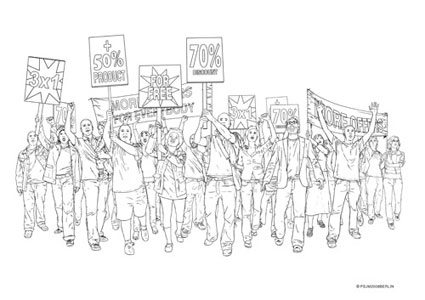 Consumer Demonstration, Mural Installation, 2007
Consumer Demonstration, Mural Installation, 2007
We don’t really find any artist whose line of work corresponds to ours, but if we had to give a couple of names it would be the Spanish group Democracia and the artistic corporation Etoy. We admire their work a lot.
Many of your works have a very strong provocative element to them which makes them very appealing for the media. How much is the “shock tactic” important in your practice?
Our work owes much to the Dadaist and Constructivist tradition and to its commitment to merge art with life. Today, reality is built by the media and if we want to be involved in reality we have to step into the media.
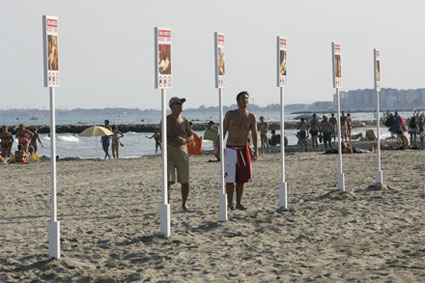
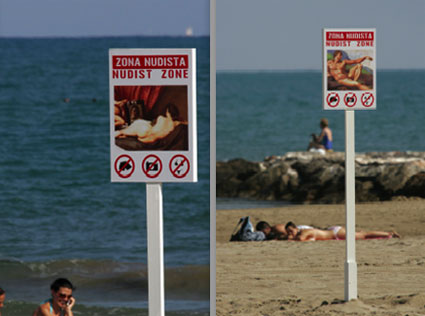 Nudist Zone, FIB-Art ’05, Intervention on the beach of Benicassim, August 2005
Nudist Zone, FIB-Art ’05, Intervention on the beach of Benicassim, August 2005
Any upcoming project you could share with us?
We are currently working on two projects which will be presented in 2009, in various galleries and institutions. Unfortunately we cannot reveal their content as we are still at the creative and production stage, but we can tell you that in one of the projects we will be using a traditional technique: painting. Our subject focuses on merchandise and painting is still the number one merchandise in the world of art.
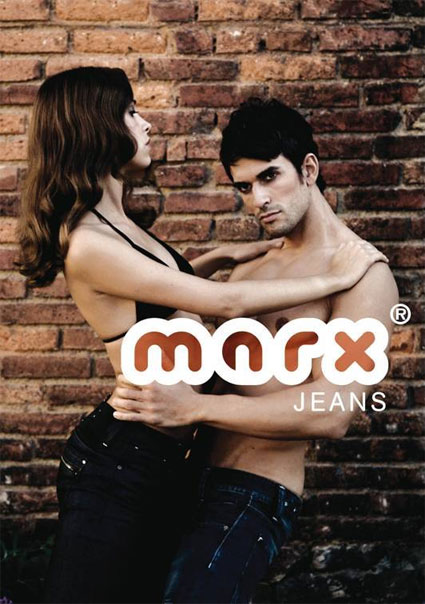 The MARX® shop at LABoral has now closed. If people want to buy one of those shirts and jeans, is there any other gallery (or shop?) they should turn to?
The MARX® shop at LABoral has now closed. If people want to buy one of those shirts and jeans, is there any other gallery (or shop?) they should turn to?
The MARX® project was produced by LABoral in collaboration with CAAM (Centro Atlántico de Arte Moderno) in Las Palmas de Gran Canaria, Canary Islands. That’s where they will travel from July to October. We are also working on its international distribution, but it is still to early to reveal the name of the possible spaces.
Thanks Cynthia and Pablo!
The MARX® exhibition is running though October 12, 2008 at the CAAM in Las Palmas de Gran Canaria, Canary Islands, Spain.
Spanish version of the interview:
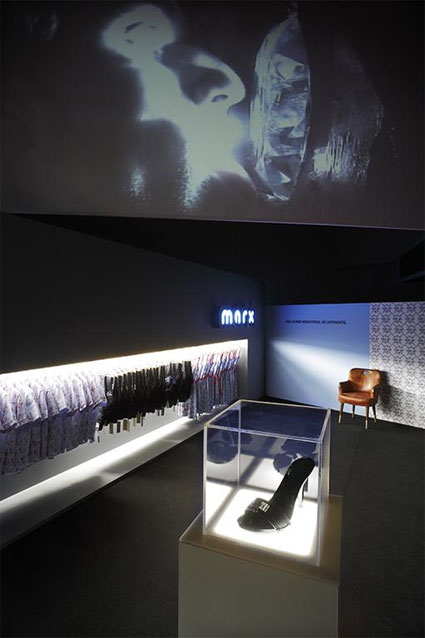 Image Marcos Morilla, courtesy of LABoral Centro de Arte
Image Marcos Morilla, courtesy of LABoral Centro de Arte
PSJM is made of artist Pablo San José and management graduate Cynthia Viera. Excuse the banality of my prejudice but how can people with such a different background manage to dialog? What brought you together? Did Cynthia’s mindset and knowledge influence Pablo’s artistic practice and view of the contemporary art landscape? And vice-versa, have Cynthia’s management skills been “affected” by her collaboration with an artist?
En realidad no tenemos backgrounds tan diferentes. En una etapa de su carrera artística Pablo trabajó bastantes años como creativo publicitario en una gran multinacional del sector creando anuncios e imagen de marca para empresas internacionales. Paralelamente a su labor como creativo publicitario, en 1998 Pablo decidió que su firma artística se convertiría en marca. Le interesaban los procesos de promoción de las firmas artísticas y su paralelismo con el resto de firmas comerciales y comenzó un trabajo que aún continúa, un proyecto que se construye con cada obra realizada. “El artista es la marca, la obra es el producto” pasó a ser el slogan de la marca PSJM. En 2003 Cynthia, licenciada en Dirección de Comercio Internacional y Marketing, y hasta esa fecha Responsable de Servicios de Marketing de una gran compañía de telecomunicaciones, se incorpora al proyecto haciendo realidad las intenciones teóricas de trabajar bajo las estructuras propias de la empresa y formalizar legalmente el equipo como una marca comercial. Desarrollamos un trabajo en equipo donde los puntos de vista de uno afectan sin lugar a dudas al trabajo del otro, pero ambos utilizamos el mismo lenguaje. Ni Pablo se corresponde con la imagen típica del artista romántico, ni Cynthia encaja con el perfil típico de una ejecutiva que persiga el máximo beneficio por encima de compromisos sociales o estéticos.
One of the striking element of the MARX® brand is the price. All the garments, be they jeans or dress, carry the same price tag (220,40 euros), while the one and only shoe available costs way more than most people could afford. What were the motivations behind the price tags?
Mientras que el marketing consiste en proporcionar satisfacción al cliente obteniendo un beneficio económico a cambio de ello como principal objetivo, nosotros utilizamos el marketing como una herramienta crítica que pueda proporcionar una satisfacción estética o intelectual al consumidor. Las “4 Ps” del Marketing Mix (product, price, promotion y placement) nos sirven para entretejer una estrategia de significación en la que cada una de estas “Ps” es tomada como una oportunidad creativa, cada “P” es utilizada como licencia poética. De este modo el producto constituye obra, el precio constituye obra, la promoción se presenta como obra y la distribución (placement) es también una parte integrante de la obra. Nos gusta llamar Marketing experimental a este proceso de experimentación de índole representacional.
Con MARX® una vez más hemos utilizado el precio como licencia poética y vehículo de significación, el hecho de que las prendas que se exhiben tengan un precio alto, crea una cierta sensación de impotencia reflexiva en el espectador, que por fin puede consumir en un museo pero se ve coartado por el carácter exclusivo de la mercancía. En todo caso y para mantener la pieza viva, seguir creando significado y entremezclando la realidad con la ficción, ya que la exposición en el CAAM comienza en julio, se harán rebajas. Veremos qué pasa.
I don’t know if you’ve read about the fight that the daughter of Che Guevara is putting to protect her father’s image.
How did you deal with the thought that some people might come up and criticize you for using Marx’ figure in a way that they consider to “be an affront to his dignity”? And did you at any moment think that you’d encounter a censorship similar to the one you experienced with your Asia project?
El carácter experimental de nuestros proyectos conlleva también una cierta incertidumbre una vez que “lanzas” la obra, aunque intentes dirigirla hacia una significación determinada nunca sabes con qué tipo de reacción te vas a encontrar. A o largo de nuestra carrera hemos tenido desde censuras de marcas, pasando por quejas de vecinos derechistas a críticas fervorosas, tanto negativas como favorables. Por ejemplo, con la intervención pública en forma de campaña publicitaria de MARX® en Gijón, a priori esperábamos algún tipo de reacción violenta al ver asociado el nombre del padre del comunismo con la estética de la moda, tanto más si tenemos en cuenta la tradición revolucionaria de Asturias, pero para nuestra sorpresa el público ya está tan acostumbrado al absurdo de los mensajes paradójicos del mercado que la pieza se diluyó en la realidad al completo. Por otro lado, en este caso difícilmente una marca nos puede censurar, como sucedió con Adidas en Proyecto Asia, ya que el primer paso conceptual y práctico del proyecto MARX® consistió en registrar la marca MARX®, y es realmente esta acción lo que supone el eje primordial de la obra, el resto únicamente puede ser visto como su desarrollo natural.
The MARX® project was accompanied by a promotional campaign in the streets of Gijon. The promo posters looked like any other posters designed by mainstream fashion brand. The general public, whether they wanted it or not, was thus in direct contact with your project. How much do you value their look and reaction to your work? Do you give it more credit and importance than you would give to an art critic or to anyone familiar with artistic discourses?
Para nosotros es primordial que nuestras propuestas no se queden exclusivamente en el terreno de la elite cultural, en la base de nuestro trabajo subyace el empeño de ampliar el discurso a un público más amplio, nos afanamos en crear obras con dos niveles de lectura intentando hermanar experimentación y comunicación. A esta difícil empresa la llamamos “el dilema de Maiakovski”, ya que este tema le quitaba el sueño al poeta ruso. Para conseguir esto nos servimos de los medios y estrategias de la cultura de masas, el público medio comprende este lenguaje a la perfección y nos brinda un campo con el que poder experimentar generando significados distintos. Sin embargo también tenemos como objetivo instalar nuestras propuestas en el seno del discurso teórico del arte contemporáneo, todos nuestros proyectos incluyen un texto redactado por nosotros que consideramos un elemento más de la obra total. Ciertamente nuestro trabajo se mueve entre la realidad y la institución arte, ambas esferas son importantes para nosotros.
You obviously don’t share Takashi Murakami’ bulldozer and very mercantile approach. However, MARX® and other projects of yours evoke (to me at least and under certain aspects) the Japanese artist’s exploration of the merging between consumer goods and artwork, art fetishism, the demythification of the concept of art work as a one-off, etc. Am i writing a total heresy or do you somehow see some similarities between his approach and yours?
Who are the other artists you feel close to?
Efectivamente hay muchos aspectos de la obra de Murakami que nos acercan a su línea de trabajo y muchos otros que nos separan de él. Los que nos vinculan a su modo de producir arte tú misma los has expuesto. Lo que nos distancia de Murakami es su falta de crítica y su posicionamiento ideológico cercano al stablishment. Murakami sigue la estela de Warhol y Koons, pero no va más allá, digamos que es un desarrollo del Pop apolítico. A Murakami le interesa hacer dinero como principal objetivo. Él tiene además un fuerte posicionamiento nacionalista, algo que a nosotros nos resulta totalmente desfasado y peligrosamente conservador. Sin embargo nuestra singularidad es que combinamos mundos aparentemente irreconciliables para crear cortocircuitos de sentido. Nuestra visión de la producción artística organizada al modo de una empresa, en la que el creador aparece como un profesional con una función social definida, sigue la estela trazada por pensadores como Proudhon o Benjamin, que rechazan la figura del artista-genio y proponen aquella otra del artista-obrero, postura que también los productivistas rusos se encargaron de llevar a la práctica mientras gozaron del apoyo del aparato del Partido. Sin embargo, del mismo modo que la modernidad dejó paso a la postmodernidad y la producción cedió su importancia al consumo, la empresa devino marca. Con lo que esta conversión de la empresa en marca recupera de algún modo el valor mitológico-simbólico del genio para configurar un aparentemente contradictorio artista-marca cuyo comportamiento es estratégicamente planificado, científicamente programado. Así que mientras por un lado se desmitifica la imagen elitista y endiosada del artista romántico, por otro se genera un nuevo mito, esta vez fríamente diseñado bajo los presupuestos de la mercadotecnia aplicada al mundo del arte. Lo paradójico, la conjunción de fuerzas opuestas e irreconciliables sobrevuela constantemente nuestro modo de hacer arte.
Realmente no encontramos ningún artista que coincida con esta línea de trabajo, pero si tuviéramos que apuntar un par de nombres serían el grupo español Democracia y la corporación artística Etoy. El trabajo de ambos grupos nos interesa y nos produce una gran admiración.
Many of your works have a very strong provocative element to them which makes them very appealing for the media. How much is the “shock tactic” important in your practice?
Nuestro trabajo está en deuda con la tradición dadaista y constructivista y su compromiso de fundir arte y vida. Hoy la realidad la construyen los medios de comunicación, si queremos intervenir en la realidad debemos introducirnos en los medios.
Any upcoming project you could share with us?
Estamos ahora preparando dos proyectos que se presentarán en el 2009, en diferentes galerías e instituciones. Por desgracia no podemos desvelar su contenido ya que aún nos encontramos en proceso de creación y producción, pero sí te podemos adelantar que en uno de ellos se utilizará la técnica tradicional de pintura. Nuestro discurso está centrado en la mercancía y la pintura sigue siendo la mercancía reina en el mundo del arte.
The MARX® shop at LABoral has now closed. If people want to buy one of those shirts and jeans, is there any other gallery (or shop?) they should turn to?
El proyecto MARX® ha sido producido por la LABoral en colaboración con el CAAM (Centro Atlántico de Arte Moderno) de Las Palmas de Gran Canaria en la Isla Canarias. Allí viajará en julio y permanecerá hasta octubre. También estamos trabajando en su difusión internacional aunque aún es pronto para adelantar el nombre de los posibles espacios.
